- Messages
- 11,640
- Location
- Constantine, MI
The temps this year have been above normal and the oppressive humidity just got to the point that it was too much for me - not to mention the delays in finishing and wood movement issues. I had planned on adding AC to the shop right from the beginning and a place was reserved and a circuit run in preparation. However, things change and reality has a way of getting in the way.
Initially I had planned for a 12,000 + BTU through the wall unit. As time went by I started leaning towards a mini split thinking that would be a much nicer install and I could also supplement my gas heat. That plan moved to the top of the list but that placement was short lived. I got a couple of estimates from local contractors and $4,000 was just way out of reach. I priced DIY units but after running the new power the cost was still well over $1,500. Better, but still more than I have to throw around.
Back to the through the wall unit. They run a little less than $500 with the install kits at about $80 -$100. Within reason. I had a through the wall unit in Idaho which is why I thought it would be a good idea here. What I forgot was that the unit in Idaho was installed in a gable end. Here it was a load bearing wall. That meant I would have to open up the wall Cut out some studs, install a header, and on and on. More work than I can do right now plus years down the road, if it needed to be replaced, I'd have a very large hole in the wall to try and match a unit to.
In speaking with one of the contractors he suggested a portable unit as an alternative that would last me a number of years so I could save up for that Mini split at the top of my list. I had read up on them before. Some people love them, some hate them. They are not terribly efficient and require venting, usually through a window. Well, I don't have any windows in the shop and I was not going to drape those hoses (I wanted the 2 hose versions as they don't suck all the conditioned air out of the room to cool the coils) across my desktop in the office. So I had to come up with a solution.
My first thought was dryer venting but the 4" size and available vent caps restricted the exhaust flow too much. Additionally, I measured the exhaust air temp at nearly 160 degrees and thought that I needed as unrestricted a flow as possible and, maybe, a need to insure the hot pipe didn't scorch anything or cause a sag in my vinyl siding. I'm probably being over cautious, perhaps 160 isn't as hot as it sounds.
What I installed was a 4" dryer vent for the intake and I used 5" B-vent double walled flue pipe for the exhaust. The rain cap is a little large but I'm getting used to it. One thing I still need to do is put some form of deflector between the exhaust and intake so I am not drawing hot air in. I'm also getting used to the dryer air at 75 degrees in the shop.
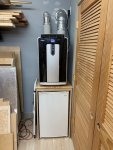
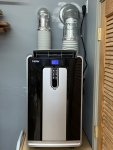
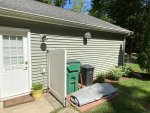
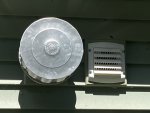
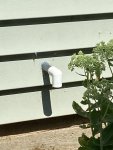
Initially I had planned for a 12,000 + BTU through the wall unit. As time went by I started leaning towards a mini split thinking that would be a much nicer install and I could also supplement my gas heat. That plan moved to the top of the list but that placement was short lived. I got a couple of estimates from local contractors and $4,000 was just way out of reach. I priced DIY units but after running the new power the cost was still well over $1,500. Better, but still more than I have to throw around.
Back to the through the wall unit. They run a little less than $500 with the install kits at about $80 -$100. Within reason. I had a through the wall unit in Idaho which is why I thought it would be a good idea here. What I forgot was that the unit in Idaho was installed in a gable end. Here it was a load bearing wall. That meant I would have to open up the wall Cut out some studs, install a header, and on and on. More work than I can do right now plus years down the road, if it needed to be replaced, I'd have a very large hole in the wall to try and match a unit to.
In speaking with one of the contractors he suggested a portable unit as an alternative that would last me a number of years so I could save up for that Mini split at the top of my list. I had read up on them before. Some people love them, some hate them. They are not terribly efficient and require venting, usually through a window. Well, I don't have any windows in the shop and I was not going to drape those hoses (I wanted the 2 hose versions as they don't suck all the conditioned air out of the room to cool the coils) across my desktop in the office. So I had to come up with a solution.
My first thought was dryer venting but the 4" size and available vent caps restricted the exhaust flow too much. Additionally, I measured the exhaust air temp at nearly 160 degrees and thought that I needed as unrestricted a flow as possible and, maybe, a need to insure the hot pipe didn't scorch anything or cause a sag in my vinyl siding. I'm probably being over cautious, perhaps 160 isn't as hot as it sounds.
What I installed was a 4" dryer vent for the intake and I used 5" B-vent double walled flue pipe for the exhaust. The rain cap is a little large but I'm getting used to it. One thing I still need to do is put some form of deflector between the exhaust and intake so I am not drawing hot air in. I'm also getting used to the dryer air at 75 degrees in the shop.





